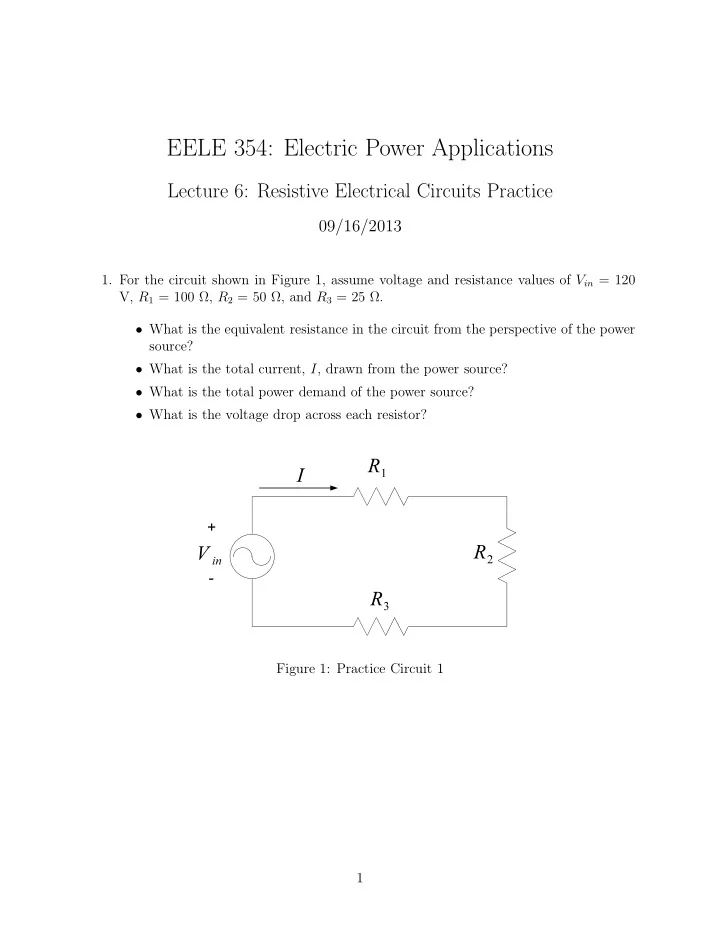

EELE 354: Electric Power Applications Lecture 6: Resistive Electrical Circuits Practice 09/16/2013 1. For the circuit shown in Figure 1, assume voltage and resistance values of V in = 120 V, R 1 = 100 Ω, R 2 = 50 Ω, and R 3 = 25 Ω. • What is the equivalent resistance in the circuit from the perspective of the power source? • What is the total current, I , drawn from the power source? • What is the total power demand of the power source? • What is the voltage drop across each resistor? Figure 1: Practice Circuit 1 1
2. For the circuit shown in Figure 2, assume voltage and resistance values of V in = 120 V, R 1 = 100 Ω, R 2 = 50 Ω, and R 3 = 25 Ω. • What is the equivalent resistance in the circuit from the perspective of the power source? • What is the total current, I , drawn from the power source? • What is the current draw through each resistor? Figure 2: Practice Circuit 2 2
3. For the circuit shown in Figure 3, assume voltage and resistance values of V in = 120 V, R 1 = 100 Ω, R 2 = 50 Ω, and R 3 = 25 Ω. • What is the equivalent resistance in the circuit from the perspective of the power source? • What is the total current, I , drawn from the power source? • What is the current through R 2 , the voltage drop across R 2 and the power dissi- pated in R 2 ? Figure 3: Practice Circuit 3 3
4. For the circuit shown in Figure 4, assume voltage and resistance values of V in = 120 V, R 1 = 100 Ω, R 2 = 50 Ω, and R 3 = 25 Ω. • What is the equivalent resistance in the circuit from the perspective of the power source? • What is the total current, I , drawn from the power source? • What is the current through R 2 , the voltage drop across R 2 and the power dissi- pated in R 2 ? Figure 4: Practice Circuit 4 4
5. Application Problem 1: The Dimmer Switch A dimmer switch for a lighting circuit can be implemented using a variable resistor (aka rheostat). In the circuit of Figure 5, let resistors R 1 through R 4 represent lightbulbs rated for 100 Watts when powered by a 120 V source. For a resistor based dimmer switch to operate well, it’s minimum resistance must be much lower than that of the load, and it’s maximum resistance must be much higher than that of the load. For this analysis, assume that the variable resistor has a minimum resistance of 0 Ω, i.e. it is a perfect short circuit, and a maximum resistance of ∞ Ω, i.e. it is a perfect open circuit. • What is the resistance of each lightbulb (assume the bulbs have been on for a long time and are at a steady temperature)? • Assuming the dimmer switch is fully on, i.e. perfect short, what is the equivalent resistance in the circuit from the perspective of the power source? • What is the voltage applied to each lightbulb when the dimmer is adjusted to have a resistance of 36 Ω? • The dimmer switch dissipates maximum power when it’s resistance is equal to the equivalent resistance of the four parallel bulbs. What must the power rating of the dimmer switch be? (Hint: it is not just 4 times 100 W)? Figure 5: The Dimmer Switch 5
6. Application Problem 2: The Wheatstone Bridge The Wheatstone Bridge is a commonly used electrical circuit for measuring changes in resistance. The circuit, or a variation thereof, is often used with strain gauges. As the gauge deforms due to stress on the measured material/device, e.g. a steel I-beam, the gauge resistance changes. In the circuit below, R 1 through R 3 are standard resistors, while R g , represents the resistance of the strain gauge. • Analyze the circuit below to show that the output voltage, V out , is given by, � � R 3 R 2 V out = V in − R g + R 3 R 1 + R 2 • If R 1 , R 2 , R 3 and the unstrained gauge resistance, R g all have the same resis- tance, R , show that the output voltage V out = 0 V regardless of the input voltage, V in . • If while under stress, the strain gauge resistance increases to R g = 3 R , what is V out ? • Hints: Can always redraw circuit so branches and resistances are vertical. Find the current through each branch first. Then find voltages across R 2 and R 3 . Figure 6: Wheatstone Bridge Circuit 6
Recommend
More recommend